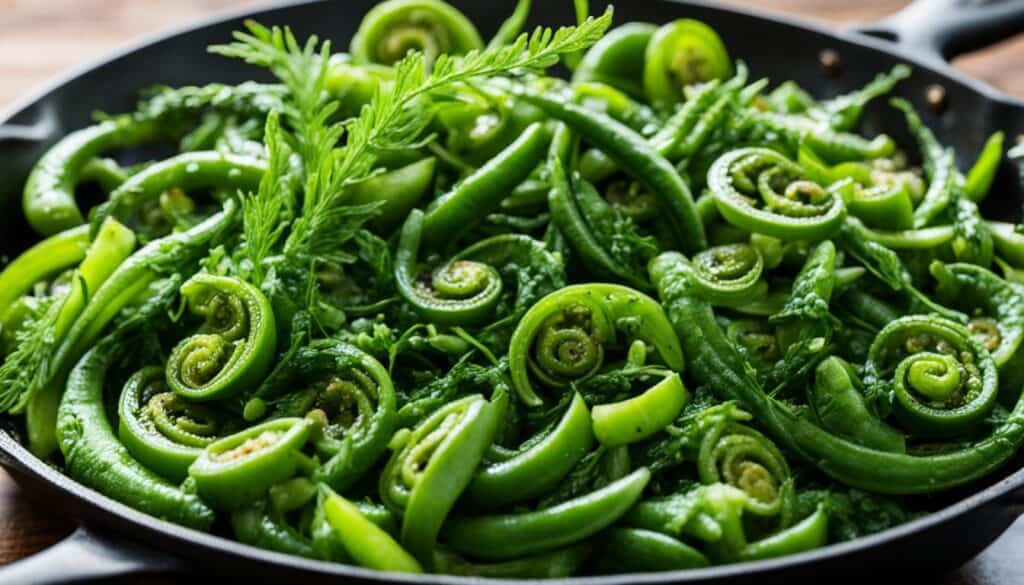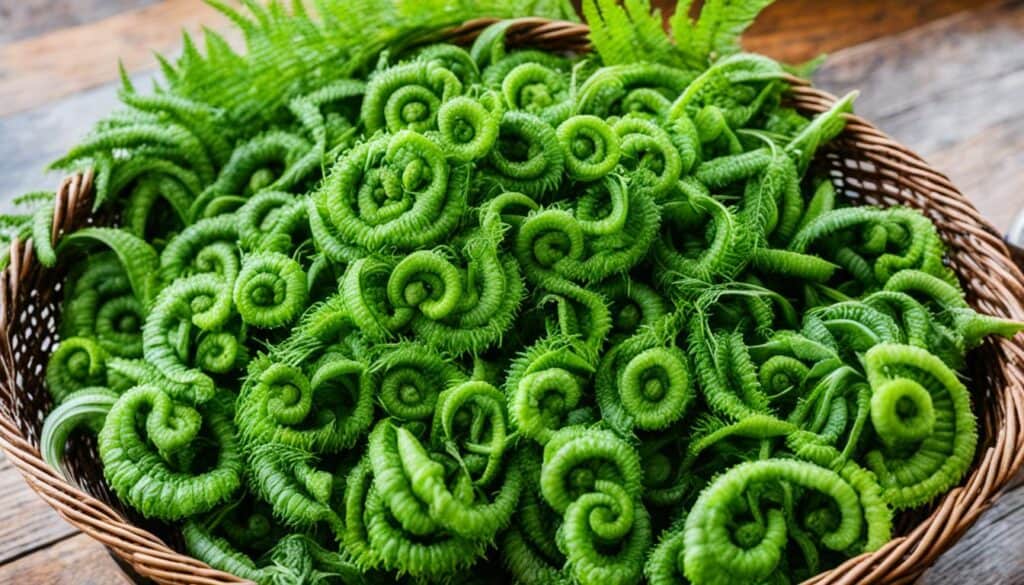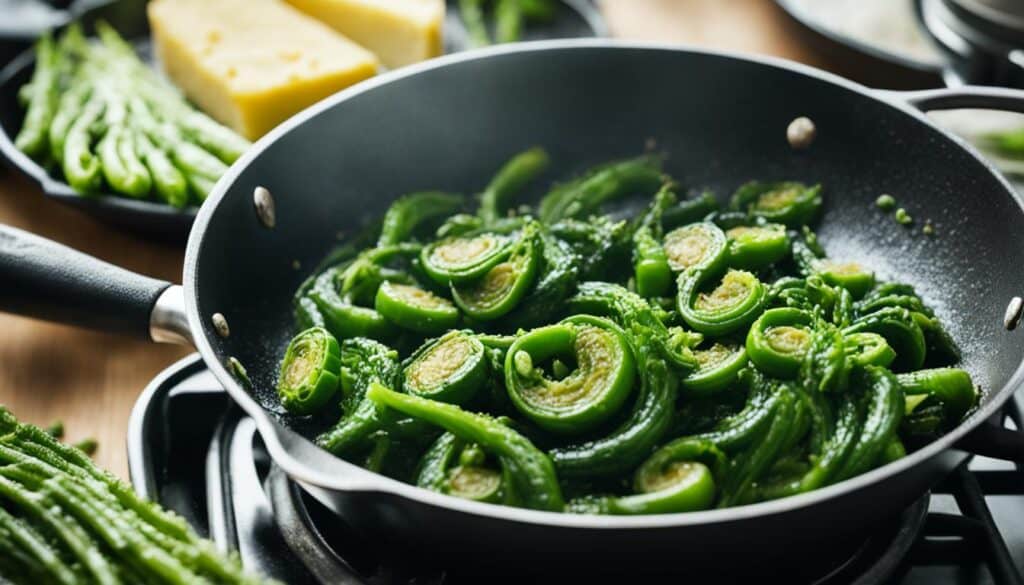Did you know that fiddlehead ferns are a highly anticipated spring delicacy? These vibrant green vegetables are not only a visual feast but also a nutritious addition to your plate. With a flavor reminiscent of asparagus and a texture similar to okra, fiddleheads bring a unique and delightful element to springtime meals.
Key Takeaways:
- Fiddlehead ferns are a beloved spring vegetable with a short harvesting season.
- They have a taste similar to asparagus and a texture reminiscent of okra.
- Fiddlehead ferns are packed with vitamins A and C, iron, potassium, and antioxidants.
- They are low in calories and fat, making them a healthy choice.
- Get creative in the kitchen and explore different recipes to enjoy these seasonal delights.
Harvesting Fiddlehead Ferns
When it comes to fiddlehead ferns, the thrill of the chase is part of the adventure. To harvest these seasonal delicacies, foraging is the way to go. Typically found along the banks of waterways, fiddleheads grow abundantly in their natural habitat. The harvest season for fiddlehead ferns is relatively short, lasting only about 30 days. Foragers often embark on a journey from the southern part of Maine to the northern border with Canada, following the elusive season as it unfolds.
During this time, enthusiasts can be seen traversing the picturesque landscape, armed with bags and baskets in search of these scrumptious spring delights. It’s a common sight to witness foragers filling their containers with fiddleheads, eager to take home a bountiful harvest.
While the allure of fiddlehead foraging is undeniable, it’s important to remember to respect private property. Always seek permission from landowners if you plan to harvest fiddleheads on their land. Respecting boundaries ensures that everyone can enjoy the excitement of foraging while preserving the environment and fostering positive relationships within the community.
Foraging Tips:
- Research the fiddlehead fern season in your area to ensure you’re harvesting at the right time.
- Learn how to properly identify fiddleheads by attending workshops or consulting experienced foragers.
- Obtain permission from landowners before foraging on private property.
- Forage responsibly by only taking a small portion of the fiddleheads, allowing the population to regenerate.
- Clean and prepare the fiddleheads properly before consuming them.
Foraging for fiddlehead ferns is not only a rewarding activity but also a way to connect with nature and experience the thrill of harvesting your food. Just remember to do it responsibly and with respect for the environment.
Cooking with Fiddlehead Ferns
When it comes to cooking with fiddlehead ferns, the options are plentiful. One popular method is to blanch them in boiling water for 2-3 minutes until they turn a vibrant green. This quick cooking technique helps to remove any bitterness and prepare the fiddleheads for further culinary adventures.
After blanching, you can get creative and experiment with different cooking methods and flavors. One delicious approach is sautéing the blanched fiddleheads in butter with garlic and lemon juice. This combination creates a mouthwatering dish that enhances the unique flavor of the fiddleheads.
If you’re a pasta lover, why not add fiddlehead ferns to your favorite pasta dishes? Whether it’s a creamy carbonara or a fresh and light primavera, fiddleheads can bring a vibrant touch of spring to your plate. The crisp texture and earthy taste of the ferns can add a delightful twist to your pasta creations.
For those who prefer lighter fare, adding fiddlehead ferns to salads is a fantastic option. Whether you’re making a refreshing green salad or a hearty grain-based salad, the addition of fiddleheads can provide a burst of flavor and visual appeal. Their tender crunch pairs perfectly with a variety of ingredients, from crisp greens to tangy dressings.
| Recipes | Description |
|---|---|
| Sautéed Fiddlehead Ferns with Butter, Garlic, and Lemon Juice | A classic preparation that highlights the natural flavor of fiddleheads. |
| Fiddlehead Fern Pasta | A delicious and hearty pasta dish featuring the unique taste and texture of fiddleheads. |
| Fiddlehead Fern and Quinoa Salad | A light and refreshing salad that combines the freshness of fiddleheads with the nutritious goodness of quinoa. |
These are just a few examples of the many ways you can incorporate fiddlehead ferns into your culinary repertoire. Don’t be afraid to experiment and try new combinations that suit your taste buds. Embrace the versatility of these springtime delights and let your creativity flow in the kitchen!
The Unique Flavor of Fiddlehead Ferns
“The crisp texture and earthy taste of fiddlehead ferns can elevate any dish, adding a delightful twist to traditional recipes.” – Me
Health Benefits of Fiddlehead Ferns
Fiddlehead ferns not only tantalize your taste buds but also offer a plethora of health benefits. Packed with essential nutrients, these delightful green spirals provide a nourishing boost to your diet.
Rich in Vitamins and Minerals
Fiddlehead ferns are a fantastic source of vitamins A and C, which play crucial roles in maintaining a strong immune system and promoting overall health. These vitamins also contribute to healthy skin and eyesight, providing a natural glow and sharp vision.
In addition to vitamins, fiddleheads are packed with iron and potassium. Iron is essential for the production of red blood cells, ensuring adequate oxygen transportation throughout your body. Potassium, on the other hand, supports healthy heart function and helps maintain proper fluid balance in your cells.
Antioxidant Powerhouse
These vibrant greens are also rich in antioxidants, which safeguard your body against oxidative stress and cellular damage. Antioxidants help neutralize harmful free radicals, reducing the risk of chronic diseases such as heart disease and certain types of cancer.
Low in Calories and Fat
If you’re watching your waistline, fiddlehead ferns make an excellent choice. They are low in calories and fat, making them a guilt-free addition to your plate. Enjoy their delectable flavor without worrying about unwanted weight gain.
Promotes Digestive Health
The dietary fiber found in fiddlehead ferns aids in digestion and promotes a healthy gut. Fiber adds bulk to your stool, preventing constipation and supporting regular bowel movements. It also nourishes the beneficial bacteria in your gut, contributing to a balanced and thriving digestive system.
With their impressive nutritional profile and numerous health benefits, fiddlehead ferns are an excellent addition to any well-rounded diet. Embrace their seasonal charm and savor the vibrant flavors and nourishment they offer.
Tips for Foraging Fiddlehead Ferns
If you are interested in foraging fiddlehead ferns, it is important to educate yourself about the proper techniques and safety precautions. As a passionate forager myself, I have gathered some valuable tips to help you make the most of your fiddlehead foraging experience.
1. Learn from Experienced Foragers
Before venturing out to harvest fiddlehead ferns, it is beneficial to learn from those who have experience in identifying and foraging them. Consider joining workshops or connecting with local foraging groups to gain valuable insights and knowledge.
2. Properly Identify the Ferns
The key to successful foraging is correctly identifying fiddlehead ferns. Take the time to familiarize yourself with their distinctive characteristics, such as the tightly curled fronds and the brown papery coating that needs to be removed before cooking. Pay attention to the unique shape and appearance to ensure you are harvesting the right plant.
3. Forage Responsibly
Responsible foraging ensures the sustainability of fiddlehead fern populations. When harvesting, only take a small portion and leave the rest to allow the ferns to grow and reproduce. This ensures a healthy ecosystem and ensures that future generations can also enjoy the natural beauty and flavors of fiddlehead ferns.
4. Seek Permission for Private Land
If you plan to forage on private land, it is essential to obtain proper permission from the landowner. Respect private property boundaries and adhere to any specific guidelines they may have for foraging. Building positive relationships and honoring the landowner’s wishes will contribute to a harmonious foraging experience.
5. Clean and Prepare Fiddleheads Properly
Once you have harvested your fiddlehead ferns, it is crucial to clean and prepare them correctly before consuming. Remove any debris, dirt, or remaining brown papery coating. Rinse them thoroughly with cool water to ensure they are free from any impurities. This step is essential for maximizing their flavor and ensuring a safe culinary experience.
By following these tips, you can embark on a successful fiddlehead foraging adventure and enjoy the satisfaction of harvesting these delightful spring delicacies.
Delicious Fiddlehead Fern Recipes
Looking for creative ways to incorporate fiddlehead ferns into your meals? Look no further! These delicious recipes will showcase the unique flavor and texture of fiddleheads, adding a fresh and vibrant element to your dishes.
-
Butter Sautéed Fiddleheads
Simple yet full of flavor, sautéing fiddleheads in butter brings out their natural taste. Heat a pat of butter in a skillet over medium heat. Add the fiddleheads, a minced garlic clove, and a squeeze of lemon juice. Sauté for 5-7 minutes until the fiddleheads are tender-crisp. Serve as a side dish or sprinkle them over grilled meats for a delicious accompaniment.
-
Fiddlehead Fern Pasta
Elevate your pasta game by incorporating fiddlehead ferns. Cook your favorite pasta according to package instructions. In a separate skillet, heat olive oil and sauté fiddleheads with minced garlic, red pepper flakes, and sliced cherry tomatoes until tender. Toss the cooked pasta in the fiddlehead mixture and top with grated Parmesan cheese for a quick and satisfying meal.
-
Fiddlehead Fern Salad
Add a crunchy and vibrant twist to your salads with fiddlehead ferns. Blanch the fiddleheads in boiling water for 2-3 minutes, then drain and rinse with cold water. Combine the blanched fiddleheads with your favorite mixed greens, sliced strawberries, crumbled goat cheese, and toasted pine nuts. Drizzle with balsamic vinaigrette and enjoy a refreshing and nutritious salad.
Experimenting with different recipes and flavor combinations will allow you to discover new and exciting ways to enjoy this seasonal delicacy. Whether you prefer the rich buttery taste, the fusion of fiddleheads with pasta, or the refreshing crunch in a salad, fiddlehead ferns are sure to impress your taste buds and add a touch of elegance to your table.
Storing and Preserving Fiddlehead Ferns
If you have harvested more fiddleheads than you can consume immediately, it is possible to store and preserve them for later use. Proper storage ensures that you can enjoy the fresh taste of fiddlehead ferns even after the short harvesting season has ended. Here are some methods for storing and preserving fiddleheads:
Refrigeration
After washing and blanching the fiddleheads to remove any bitterness, you can store them in the refrigerator for up to three or four days. When storing fiddleheads in the refrigerator, it is important to place them in an airtight container or seal them in a freezer bag to maintain their freshness. This method is ideal if you plan to use the fiddleheads within a few days.
Freezing
Freezing fiddleheads is a great option if you have a surplus and want to enjoy them throughout the year. To freeze fiddleheads, blanch them for about 2-3 minutes and then quickly cool them in ice water. After cooling, pat them dry and transfer them to airtight containers or freezer bags. Make sure to remove as much air as possible to prevent freezer burn. Frozen fiddleheads can be stored for several months and retain their flavor and nutritional value.
Here’s a step-by-step guide to freezing fiddlehead ferns:
- Wash the fiddleheads thoroughly to remove any dirt or debris.
- Blanch the fiddleheads in boiling water for 2-3 minutes.
- Quickly cool the blanched fiddleheads in ice water to halt the cooking process.
- Pat the fiddleheads dry with a clean kitchen towel or paper towel.
- Transfer the dried fiddleheads to airtight containers or freezer bags.
- Label the containers or bags with the date and freeze them.
When you’re ready to use frozen fiddleheads, there’s no need to thaw them. Simply cook them directly from frozen, adjusting the cooking time as needed.
Fiddlehead Ferns as a Seasonal Delight
Fiddlehead ferns are a true seasonal delight, with a short harvest window that typically lasts for about 30 days in the spring.
The exact timing of the fiddlehead fern season can vary depending on the location and climate. In Maine, the season usually begins when the fern fronds start to emerge and continues until the fronds fully unfurl.
The arrival of fiddlehead ferns signals the transition from winter to spring and is eagerly awaited by many.
The Beauty of Fiddlehead Fern Season
The fiddlehead fern season is a much-anticipated time of year for food enthusiasts and nature lovers alike. The emergence of these delicate green shoots signifies the end of winter and the beginning of a new season filled with fresh flavors and vibrant colors.
One of the unique aspects of fiddlehead ferns is their limited availability. With a harvesting window that typically lasts for only about 30 days, fiddlehead ferns are a fleeting culinary treasure that must be savored during their short-lived season.
During this time, foragers and local markets come alive with the vibrant green hues of these edible delicacies. Restaurants and home cooks alike eagerly incorporate fiddlehead ferns into their menus, showcasing the beauty and flavor of this fleeting springtime delight.
The Flavorful Journey of Fiddlehead Ferns
As the fiddlehead fern season begins, so does the culinary adventure of exploring their unique flavor profile. Fiddleheads have a distinct taste that can be described as a combination of asparagus and okra, with a hint of nuttiness.
Their tender texture and subtle bitterness make them a versatile ingredient in various dishes. Whether sautéed, roasted, or added to soups and salads, fiddleheads bring a fresh and vibrant dimension to any meal.
Their flavor pairs well with complementary ingredients like citrus, garlic, butter, and herbs, allowing for endless creative possibilities in the kitchen.
| Fiddlehead Fern Flavor Pairings | |
|---|---|
| Citrus | Garlic |
| Butter | Herbs |
Embracing the Seasonal Delight of Fiddlehead Ferns
During the fiddlehead fern season, it’s an opportune time to experiment with new recipes and embrace the fleeting availability of these delightful greens. Here are a few ideas to inspire your culinary exploration:
- Sauté fiddleheads with garlic and lemon for a simple side dish.
- Add blanched fiddleheads to pasta for a fresh and vibrant twist.
- Blend cooked fiddleheads into a creamy soup for a rich and unique flavor.
- Toss raw fiddleheads into a salad for a delightful crunch.
Whatever recipe you choose, remember to highlight the natural taste of fiddlehead ferns and celebrate their seasonal charm.
“The fiddlehead fern season is like a fleeting whisper of spring, adding a touch of freshness and excitement to our culinary experiences. Embrace the beauty of these delicate greens and savor the unique flavors they bring to the table.”
Exploring the Fiddlehead Fern Season
When the fiddlehead fern season arrives, it’s not just about the culinary delights. It’s also an opportunity to immerse yourself in nature and appreciate the changing seasons.
Take a stroll through wooded areas or near waterways where fiddleheads flourish. Observe the unfolding fronds, marvel at their intricate patterns, and rejoice in the signs of life returning after a long winter.
Whether you’re foraging for fiddleheads, enjoying them in a restaurant, or preparing them at home, the fiddlehead fern season is a time to celebrate the beauty and flavors of nature.
Fiddleheads in Culinary Culture
Fiddlehead ferns have become an integral part of the culinary culture in Maine and other regions where they grow abundantly. These vibrant and flavorful vegetables have made their way onto the menus of local restaurants and cafes, captivating the taste buds of food enthusiasts. As a versatile ingredient, fiddlehead ferns are used in various dishes, allowing chefs and home cooks to showcase their unique taste and texture.
When it comes to cooking with fiddleheads, the possibilities are endless. Chefs and cooks love to experiment with different recipes and techniques, finding ways to bring out the natural essence of these seasonal delights. From sautéing them in butter with a hint of garlic to incorporating them into pasta dishes and salads, fiddleheads can add a fresh and vibrant element to any culinary creation.
“Fiddleheads are like nature’s gift to the kitchen. Their distinct flavor and delicate texture inspire me to create unique dishes that celebrate the beauty of seasonal produce.” – Chef Emily Adams
The popularity of fiddlehead ferns extends well beyond the borders of Maine. Foragers and food enthusiasts from all over the country eagerly seek out these springtime delicacies, exploring the culinary possibilities they offer. Whether it’s through local markets or adventurous foraging expeditions, the demand for fiddleheads continues to grow, as more people discover and appreciate their irresistible charm.
Fiddlehead Fern Recipes
| Recipe | Description |
|---|---|
| Sautéed Fiddleheads | Fiddleheads lightly sautéed in butter with garlic, lemon juice, and a pinch of salt for a simple and flavorful dish. |
| Fiddlehead Pasta | Tender fiddleheads tossed with al dente pasta, olive oil, parmesan cheese, and fresh herbs for a satisfying and aromatic meal. |
| Fiddlehead Salad | Blanched fiddleheads combined with crisp lettuce, cherry tomatoes, avocado, and a tangy vinaigrette for a refreshing and nutritious salad. |
| Fiddlehead Stir-Fry | Fiddleheads stir-fried with an array of colorful vegetables, ginger, soy sauce, and a hint of sesame oil, yielding a vibrant and savory stir-fry. |
No matter how fiddleheads are prepared, their presence in the culinary culture is undeniable. As more people delve into the world of fiddlehead ferns, they discover an ingredient that not only delights the senses but also celebrates the beauty of nature’s bounty. So, whether you are a seasoned chef or an enthusiastic home cook, embrace the culinary culture of fiddlehead ferns and allow their unique flavors to elevate your dishes.
The Fascinating World of Fiddlehead Ferns
Fiddlehead ferns are a fascinating and unique vegetable that captivates many with its distinctive shape, flavor, and cultural significance. While they are best known for their use in culinary preparations, fiddlehead ferns also have other interesting aspects. They are actually the tightly curled sprouts of the ostrich fern and resemble the end of a fiddle, hence their name. Fiddleheads have been a part of the diet of Indigenous peoples for centuries and continue to be treasured as a seasonal delicacy.
The Curled Sprouts of the Ostrich Fern
Fiddlehead ferns are not your average vegetable. They are the young, coiled fronds of the ostrich fern (Matteuccia struthiopteris), a species that thrives in moist woodland areas. The fronds of the ostrich fern unfurl in late spring, but it is during their early stages of development, when they are still tightly coiled, that they are harvested as fiddleheads.
“Fiddlehead ferns are like little treasures hidden in the forest, waiting to be discovered and enjoyed.”
The unique shape of fiddlehead ferns is one of their defining characteristics. They resemble the end of a fiddle or a violin bow, with their tightly coiled heads and slender stalks. This distinct shape adds a whimsical touch to any dish and makes them visually appealing on the plate.
A Cultural and Culinary Tradition
For centuries, fiddlehead ferns have been an important part of the diet and cultural traditions of Indigenous peoples in various regions. These edible ferns were valued for their nutritional benefits, as well as their availability during the spring season. Today, fiddleheads continue to be highly sought after and appreciated for their unique flavor and seasonal availability.
“Fiddlehead ferns hold a special place in our culinary heritage, connecting us to the land and the changing seasons.”
In culinary traditions across different cultures, fiddlehead ferns have taken center stage in a variety of dishes. From stir-fries and sautés to salads and soups, fiddleheads bring a fresh and vibrant element to the plate. Their delicate flavor, often described as a combination of asparagus and green beans, pairs well with a range of ingredients and spices, allowing for endless culinary possibilities.
Exploring the Fiddlehead Ferns
As you delve into the captivating world of fiddlehead ferns, it’s important to embrace their unique qualities and cultural significance. Let their tightly coiled heads and verdant colors inspire your creativity in the kitchen. Whether you’re a seasoned forager or simply a curious food lover, fiddlehead ferns offer a delightful opportunity to explore new flavors, connect with nature, and celebrate the beauty of the changing seasons.
Conclusion
Fiddlehead ferns are a unique and highly anticipated springtime delight. These vibrant green ferns not only bring a taste of spring to your plate but also offer a wealth of health benefits. With their distinct flavor and texture, fiddleheads bring a fresh and vibrant element to any meal.
Whether you choose to forage for fiddleheads yourself, pick them up at local markets, or enjoy them at a restaurant, there are endless possibilities for incorporating them into your cooking. From sautéing them in butter with garlic and lemon juice to adding them to pasta dishes or salads, the versatility of fiddlehead ferns allows you to unleash your culinary creativity.
In addition to their delicious taste, fiddlehead ferns are packed with nutritional benefits. They are a good source of vitamins A and C, as well as iron and potassium. Plus, they contain antioxidants that help protect against cellular damage. With their low calorie and fat content, fiddleheads make a healthy and flavorful addition to any diet.
So, don’t miss out on the fiddlehead fern season. Embrace the fleeting beauty of this natural treasure, and discover the joy of cooking with fiddleheads. Let their unique flavor and nutritional benefits take center stage in your springtime meals. Happy cooking!










Leave a Reply